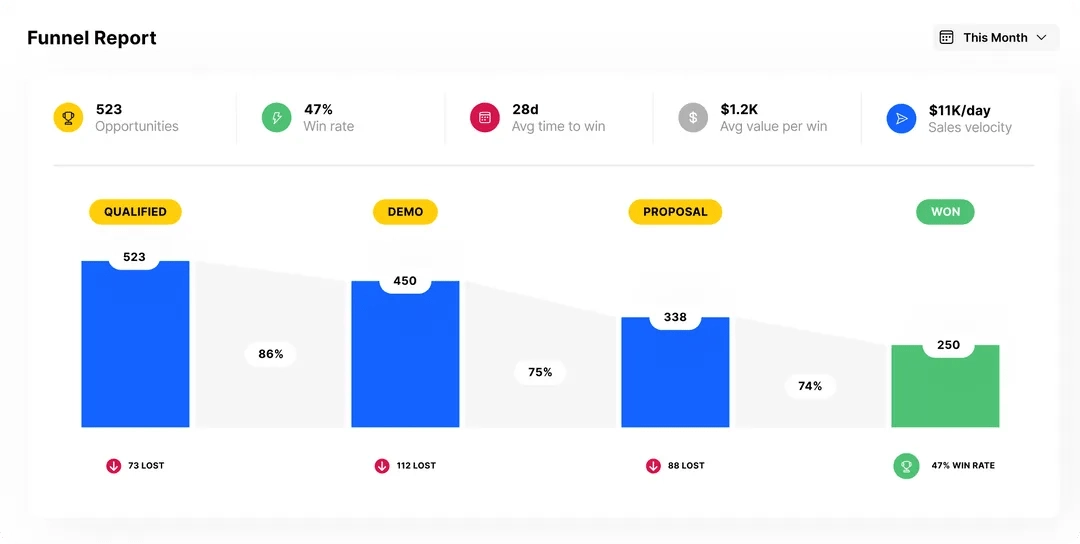The sales pipeline review. Probably the one meeting that makes your sales reps sweat the most.
But its purpose is crucial: Keep deals moving through the funnel.
Perhaps you’ve just put on your new sales manager shoes, or perhaps the way you currently review your pipeline is broken. Regardless of your situation, in this post, we’ll cover the basics of how to structure your pipeline review meetings.
Let’s make sure your reps leave the pipeline review meeting with a winning funnel that’ll accelerate their sales cycle.
Sounds good? Here we go.
The 5 Risks of not Running Great Pipeline Reviews
First things first: What’s a sales pipeline review? A sales pipeline is the visual representation of all the deals a sales rep is actively working on and trying to get to a close.
This could be in a spreadsheet, on a whiteboard, or in an inside sales CRM like Close.
if (window.convertflow == undefined) {
var script = document.createElement('script');
script.async = true;
script.src = "https://js.convertflow.co/production/websites/10698.js";
document.body.appendChild(script);
};
#cta_62206 .cf-form-2.cf-form-theme-default.cf-form-vertical.cf-field-regular button {
height: 40px !important;
}
#cta_62206 .section-overlay,
#cta_62206 .cf-section-overlay {
border-radius: 6px !important;
}
#cta_62206 {
margin: 3rem 0rem 3rem 0rem !important;
}
.post__content p:first-of-type {
margin-bottom: 0rem !important;
}
#cta_62206 .cf-form-2.cf-form-theme-default .cf-consent-label {
margin-bottom: 1rem;
color: #DBD6D6;
}
Without a sales pipeline review, you will:
- Not have an overview of the overall health of your team’s sales pipeline
- Not understand the external and internal context of the deals
- Miss challenges and threats in the pipeline
- Lack insight into your reps’ performance and capabilities
- Have sales forecasts that are off
A pipeline review serves as both a training tool for your reps and as an evaluation tool to determine the current state of your sales.
If you do your sales pipeline reviews correctly, it should lead to more closed deals and increased revenue.
The Structure of a Successful Pipeline Review
A sales pipeline review can come in many different formats. Based on the structure of your sales team, here are a few things to take into consideration:
- Frequency
- Weekly
- Biweekly
- Monthly
- Size
- 1-on-1s
- Rotation
- Entire team
- Duration
- Duration will vary based on team size, but a 30–60-minute meeting should be enough.
- Structure
- Review all deals in the pipeline
- Review only high-priority deals
- Action
- Each review should conclude with clear action items for each rep and their respective deals. These can be anything from how to tackle an obstacle, negotiate, or kill a deal.
You don’t have to have a set structure; trial and error is your friend. See what works for your team and your business, and adjust accordingly.
4 Steps to Run a Review Like a Pro
Now that you know the format, let’s tackle what should happen during the review.
1. Ask Your Rep to Provide a Summary of the Deal
First off, your rep should bring you up to speed by providing a summary of the deal.
The summary should include:
- What’s happened so far?
- What are the next steps?
- What needs to happen to close the deal?
- What’s the anticipated timeline?
During that summary, you’re likely to discover one or more obstacles that’ll jeopardize the deal. That’s when the next stage comes in.
2. Identify Obstacles and Challenge Your Rep
To determine the likelihood of the deal closing, you need to identify the obstacles to it.
Here’s what to look out for:
- Are there any communication gaps?
- Is there any missing information?
- How has your rep managed objections so far?
- What’s currently preventing this deal from moving towards the close?
For most deals, you’ll have questions about missing information. If there are many things your rep doesn’t know about the prospect, it’ll be difficult to understand the likelihood of this deal closing.
if (window.convertflow == undefined) {
var script = document.createElement('script');
script.async = true;
script.src = "https://js.convertflow.co/production/websites/10698.js";
document.body.appendChild(script);
};
#cta_73113 .cf-form-2.cf-form-theme-default.cf-form-vertical.cf-field-regular button {
height: 40px !important;
}
#cta_73113 .cf-background-size-cover {
background-size: cover !important;
border-radius: 6px !important;
}
#cta_73113 {
margin: 3rem 0rem 3rem 0rem !important;
}
.post__content p:first-of-type {
margin-bottom: 0rem !important;
}
#cta_73113 .cf-form-2.cf-form-theme-default .cf-consent-label {
color: #fff;
margin-bottom: 1rem;
}
#cta_73113 .cf-form-2.cf-form-theme-default .cf-consent-label {
line-height: 16px !important;
}
3. Create Action Items That Will Move the Deal Forward
Toward the end of the review, you should clearly know what needs to happen next to move the deal further along in the pipeline.
Action items could be:
- Proposing a specific solution
- Managing an objection
- Reaching a decision-maker
- Negotiating the contract
- Killing a deal
You should know if the rep truly understands the prospect well enough to control the process and close the deal.
4. Embrace Urgency
If you’re reviewing a deal and something urgently requires action, such as sending an email or making a call, don’t wait until the meeting is over—act immediately.
The sales rep can leave the room, do what needs to be done, and then return and continue to participate in the pipeline review.
Maximize the ROI of Every Pipeline Review
Perhaps one of your reps is missing some crucial information. If this is something that happens repeatedly, then it’s a red flag. The rep is simply not doing a good enough job qualifying their prospects.
While it might be unpleasant, address this immediately.
The great thing is that when you coach an individual rep on something, the rest of the sales team can also learn from that experience.
Everyone on the team can gain knowledge and ideas that they can apply to their own deals to accelerate their sales cycle.
Follow up on the Last Pipeline Review
You want to do your pipeline reviews often enough to remember what happened in the last one. This gives you the opportunity to follow up on the action items created and hold your reps accountable.
Check-in on the most important deals and see how they have progressed since the last meeting. Ask for a full update on these before moving forward with the rest.
#section680292.cf-section {
margin-top: 2rem;
margin-bottom: 4rem;
box-shadow: 0 8px 32px rgb(155 162 189 / 50%);
border-radius: 8px !important;
}
.post__content p:first-of-type {
margin-bottom: 0rem !important;
}
#cta_79629 .cf-column[column-position="first"] {
display: block;
border-radius: 8px 0px 0px 8px !important;
}
#cta_79629 .background-overlay,
#cta_79629 .section-overlay,
#cta_79629 .cf-background-overlay,
#cta_79629 .cf-section-overlay {
border-radius: 8px;
if (window.convertflow == undefined) {
var script = document.createElement('script');
script.async = true;
script.src = "https://js.convertflow.co/production/websites/10698.js";
document.body.appendChild(script);
};
Using Close to Review Your Sales Pipeline
Every Monday, we do our weekly sales pipeline review at Close.
First, we look at the Opportunity Funnel report:

This gives us an overall view of our current sales pipeline, including the current win rate, sales velocity, and where deals are converting higher or lower in the sales funnel.
Next, we use the Opportunities Pipeline page in Close to get a complete overview of active deals this week.

On this page, we see the following information:
- Number of opportunities in each stage
- Leads
- The total value of deals
- Expected value
- Value of individual deals
- Confidence level
- Expected close date
- Status
- User
Depending on the size of the deal (value) or specific challenges that need to be addressed, we look at the individual Lead page to get more context around the deal.
Next, we go to the Lead page where we look at the entire interaction history.

The Lead page gives us an instant overview of the deal and what’s happened so far.
Here, in a matter of seconds, we can see three red flags:
- The sales rep waited 6 days to follow up after the sales demo. Why?
- The most recent call note has no action item. What does approval from the CEO entail?
- Tasks and notes are missing in the timeline → Can’t get the full context of the deal.
The more information provided on the lead page and its timeline, the better your understanding of the deal will be.
In this situation, we’d do two things:
- Ask the sales rep to add the missing information.
- Create the tasks that are needed to move the deal forward.
In the next pipeline review, we’ll see if those action items have been accomplished.
5 Benefits of Running Pipeline Reviews
Once your pipeline review has been completed, you should:
- Have a better understanding of the performance and capabilities of your sales reps
- Have more context around the deals in the pipeline
- Be able to forecast which deals will close more accurately
- Be able to adjust the expectations of both your sales reps and the rest of the team
- Be able to provide your reps with actionable next steps
If you’ve accomplished the above, your sales pipeline review succeeded.
Next, look at your sales pipeline review process and think about how you can improve it.
Want to do your next sales pipeline review in Close? Try it for free for 14 days and see how it can help your sales process. Go ahead and start your trial today. (No credit card required.)












